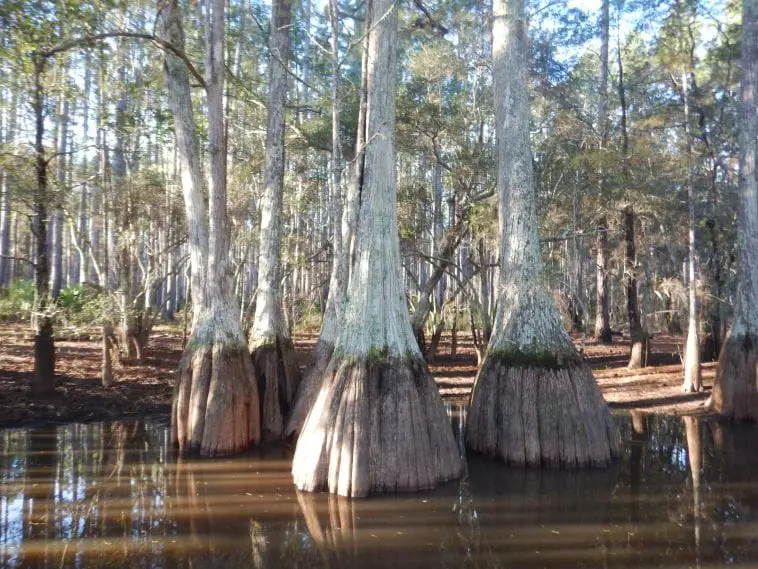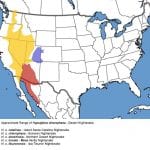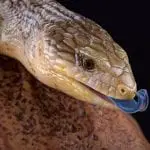Reptiles and amphibians are groups of animals that depend and rely on specific environments in order for them to survive. The places they described are called “environmental niches.” Niches are defined as specialized habitats that are made especially for these creatures.
What Makes Florida A Good Niche for Amphibians?
You might think Florida is not a good area for finding a niche for amphibians as it is a seemingly flat area with little to no evidence of the existence of these niches. Even though Florida is the flattest state in the United States, it has warm weather and small changes in ground elevation or microtopography. This is why Florida can be considered as a unique place that is perfect for reptiles and amphibians.
In this article, we will be giving focus to explore the diversity of the ephemeral ponds within Florida and the endemic and native amphibians that depend on it. Ephemeral ponds can be described as a fishless pond habitat. They are also small, isolated, wetlands that dry periodically. These ponds are able to dry up seasonally as well as being present the whole year round in some cases.
If you are planning to take a vacation to see Florida, you should expect seeing rain. Water is the most temporary or most changeable part of any type of habitat. It can be influenced by natural events or things made by humans. Some natural events are weather changes, climate changes, and pollution run-off.
Because of this, the marsh, wetland, and estuarine habitats of the state of Florida can hold many species of animals, whether they are common animals or endangered individuals, and all of them rely on the protection and management of these temporary and transitional housing areas.
Dipnetting & Its Role In The Fishless Ponds of Florida

To learn a lot more about these locations, biologists have applied the dipnetting technique to survey the amphibians living in the fishless ponds around state parks. These things require permits before being allowed to study the ecological status of these locations.
During the wet season of Florida, which is usually in the summers, the ponds get filled up with water. This occurrence makes it much easier for this area to serve as the home for many animals that need to survive in areas of both dry and wet, which makes it the perfect spot for amphibians.
Florida, which is most commonly known as “The Sunshine State,” actually is better suited to be called a Water State because the entire state is about 20% covered with some type of water. Most of the bodies of water are estuaries, lakes, marshes, rivers, and wetlands. In fact, the aquatic habitats in Florida, like the state’s wetlands, are considered unique because they are reliant on water fluctuations called hydroperiods. Even when these bodies of water dry up, the soil found there is most commonly used by species of amphibians that are best suited for amphibian life cycles. In fact, some scientists note that about 10 to 20 species of amphibians can be found in one specific pond.
Because of the dipnetting method, it has been discovered by some scientists that there are multiple species of tadpoles that can be found living in the areas of ephemeral ponds while there are no species of tadpoles that can be found in the ponds that are dominated with fishes.
The unique impressions of ponds that can be found on the earth get filled with water seasonally, or sometimes a whole year-round, and it allows many species of frogs, salamanders, and toads to breed their young, deposit their eggs, and live their entire lives without having to worry. And because there are no fishes present in the area, the tadpoles and babies are free to grow up without having to face the threats of predation.
Are Fishless Ponds Important In Florida’s Ecosystem?

If there are no ephemeral ponds in Florida, many of these amazing amphibians would not have the opportunity to achieve a balanced and stable population number and continuously reproduce. This is because fishes love eating these eggs and larvae.
The preservation of this type of system is essential because it supports metamorphosis and transitioning species. It also promotes a unique and transitional habitat that will connect and coordinate the aquatic phase and the terrestrial phase of these different amphibian species. It even supports the life cycle of birds, mammals, reptiles, and inverts.
In fact, adult amphibians choose to live here opportunistically and exclusively and to breed more to expand their population. Because of this, Florida serves as a home to an amazing species diversity level compared to other states. The young larvae are even provided with a safe nursery to living in and grow until they are able to go out of the water by themselves. These young ones are also exposed to an expanded list of invertebrates like beetles and mosquitoes.
Which Specific Amphibians Are Noted To Reside In Florida?
Some of the species who depend on the ephemeral ponds of Florida include the Tiger Salamander, Striped Newt, Southern Leopard Frog, and Eastern Spadefoot Toad. They thrive in these locations because it matches their sensitive and porous skin. These animals are also referred to as “indicator species” because they can detect pollution in a specific community.
This specific and sensitive habitat can support the fragile life of many of these species, which start their life stages while living in water and eventually transition to living a life on land. It is also important to note that preservation is essential in this type of animal, and preservation is also indicative of their survival in their area.
According to the Florida Fish and Wildlife Conservation Commission, these are the amphibians that are known to reside in the state:
1. Tree Frogs
- American Green Tree Frog
- Australian Green Tree Frog
- Barking Tree Frog
- Bird-Voiced Tree Frog
- Cope’s Gray Tree Frog
- Cuban Tree Frog
- Gray Tree Frog
- Little Grass Frog
- Mexican Leaf Frog
- Northern Cricket Frog
- Ornate Chorus Frog
- Pine Barrens Tree Frog
- Pine Woods Tree Frog
- Red-Eyed Treefrog
- Sierran Chorus Frog
- Southern Chorus Frog
- Southern Cricket Frog
- Spring Peeper
- Squirrel Tree Frog
- Upland Chorus Frog
2. True Frogs
- American Bullfrog
- Bronze Frog
- Carpenter Frog
- Florida Bog Frog
- Gopher Frog
- Green Frog
- Pig Frog
- River Frog
- Southern Leopard Frog
3. Rain Frogs
- Common Coqui
- Greenhouse Frog
- Upland Coqui
4. True Toads
- Asian Common Toad
- Blomberg’s Toad
- Cane Toad
- Fowler’s Toad
- Oak Toad
- Southern Toad
5. American Spadefoot Toads
- Eastern Spadefoot
6. Narrow-Mouthed Frogs
- Eastern Narrow-Mouthed Toad
- Banded Bullfrog
7. True Salamanders & Newts
- Chinese Fire Belly Newt
- Eastern Newt
- Japanese Fire Belly Newt
- Paddletail Newt
- Striped Newt
8. Sirens
- Lesser Siren
9. Amphiuma
- One-Toed Amphiuma
10. Mole Salamanders
- Eastern Tiger Salamander
- Frosted Flatwoods Salamander
- Marbled Salamander
- Mole Salamander
- Reticulated Flatwoods Salamander
11. Lungless Salamanders
- Apalachicola Dusky Salamander
- Dwarf Salamander
- Four-Toed Salamander
- Georgia Blind Salamander
- Many-Lined Salamander
- Rusty Mud Salamander
- Seal Salamander
- Southeastern Slimy Salamander
- Southern Dusky Salamander
- Southern Red Salamander
- Three-Lined Salamander
Are There Threats Against Fishless Ponds?
While climate change, pollution, and urban development affect the fishless ponds, it can also be threatened by invasive fish. This happens when some people think that they must introduce populations of fishes into ephemeral ponds. People stock these fishes into the ponds so that they can raise fishes of their own, may it be for personal reasons and commercial reasons. But, people should be wary that this practice is highly illegal, and this will also disrupt the ecological balance of the niche. Bringing fishes in the pond will decrease the amphibian populations because the fishes will make the young larvae a part of their meals. But, if this type of system will be preserved, the amphibians that live in Florida can thrive well and survive through this extraordinary natural niche!



